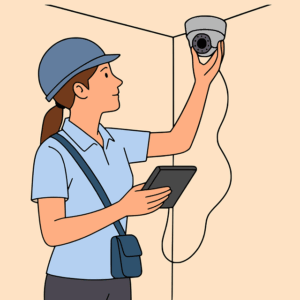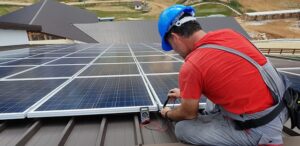Optimal HVAC Performance: When and How to Replace Filters for Efficient HVAC Repair
Regularly changing your HVAC system's air filter is crucial for maintaining optimal indoor air quality, maximizing system efficiency, and preventing costly repairs. HVAC repair services often emphasize this as a key preventative measure. Filters should be inspected and …….

Regularly changing your HVAC system's air filter is crucial for maintaining optimal indoor air quality, maximizing system efficiency, and preventing costly repairs. HVAC repair services often emphasize this as a key preventative measure. Filters should be inspected and replaced every 1 to 3 months depending on the type and local environmental factors. This simple maintenance task can extend your HVAC system's lifespan, improve energy efficiency, and reduce utility bills. Different air filters, including disposable fiberglass, pleated options with varying MERV ratings, HEPA filters for allergy sufferers, electrostatic filters that use static charges to trap particles, and media filters for larger systems, are available to suit different needs. Selecting the appropriate filter for your system supports its performance and contributes to cleaner indoor air. Remember, consistent filter maintenance is a cost-effective way to ensure your HVAC system operates efficiently and avoids the need for extensive repairs.
Maintaining your HVAC system’s peak performance is essential for both comfort and energy efficiency. A key factor in this upkeep is the regular replacement of worn filters, a task that can significantly impact your system’s effectiveness and longevity. This article delves into the importance of HVAC filter maintenance, offering comprehensive guidance from understanding the role of these filters to mastering the art of replacement. Whether you’re a homeowner looking to tackle this task yourself or considering professional HVAC repair services for optimal results, we provide valuable insights on the frequency of replacements, the types of filters suitable for different systems, and the cost-benefit analysis of consistent maintenance. Learn how to choose the right filter, monitor your system’s health post-replacement, and explore advanced technologies that can enhance your HVAC system’s performance. With our year-round maintenance guide and case studies highlighting improved performance after filter replacements, ensure your HVAC system runs efficiently and keeps your indoor air quality high.
- Understanding the Importance of HVAC Filters
- Signs It's Time to Replace Your HVAC Filter
- Step-by-Step Guide to Replacing an HVAC Filter
- Types of Filters for Different HVAC Systems
Understanding the Importance of HVAC Filters

Regular maintenance of HVAC systems is crucial for maintaining indoor air quality and ensuring efficient operation. A vital component of this maintenance is the replacement of worn filters, which play a significant role in protecting the system from dust, debris, and other contaminants. Over time, these filters become clogged, restricting airflow and impairing the system’s ability to heat or cool effectively. By replacing filters as recommended—usually every 1 to 3 months depending on the filter type and local environmental conditions—homeowners can prevent unnecessary wear and tear on their HVAC system, which in turn helps to avoid costly HVAC repairs. Additionally, clean filters contribute to a longer lifespan of the system and can help to reduce energy consumption, leading to lower utility bills. It’s imperative for homeowners to understand the importance of these filters and the impact they have on overall system performance and indoor comfort. Regularly scheduled filter checks and replacements should be an integral part of any HVAC maintenance plan to ensure that the air handling system operates at peak efficiency, providing clean, conditioned air throughout your living spaces.
Signs It's Time to Replace Your HVAC Filter

When your HVAC system is functioning optimally, it maintains a comfortable environment within your home by regulating temperature and humidity levels. However, over time, your system’s filters can become clogged with dust, pollen, and other airborne contaminants. Regular inspection and replacement of these filters are crucial for maintaining efficiency and ensuring the longevity of your HVAC system. Here are some indicators that it may be time to replace your HVAC filter: an increase in allergy symptoms among household members could signal a dirty filter restricting airflow and circulating accumulated debris. Similarly, if you notice a decrease in air quality or a musty odor emanating from your vents, this often points to a clogged filter that’s no longer effectively trapping pollutants. Another telltale sign is an unexpected rise in your energy bills, as a dirty filter can cause your system to work harder and consume more power. Lastly, if your HVAC system is producing less airflow than usual or making strange noises during operation, it’s likely that the filter needs attention, which could be part of a broader HVAC repair effort. Regular maintenance, including prompt filter replacement, is key to preventing more extensive repairs and ensuring your HVAC system operates at peak performance.
Step-by-Step Guide to Replacing an HVAC Filter

When it comes to maintaining your home’s comfort and efficiency, replacing your HVAC system’s filter is a critical task. A dirty or clogged filter restricts airflow, which can lead to reduced system performance and higher energy bills. Moreover, it can cause unnecessary wear and tear on your HVAC components. To ensure optimal system performance, it’s advisable to inspect and replace your HVAC filter every 1 to 3 months or as recommended by the manufacturer. Here’s a step-by-step guide to help you through the process:
Begin by locating your HVAC system’s air filter. Typically, it is found either behind the return air grille on your wall or ceiling or within the HVAC unit itself, usually near the blower assembly. Once you’ve located the filter, carefully remove the old one. Take note of the filter’s size and type, as these details are crucial for purchasing a suitable replacement. It’s important to select an HVAC repair-grade filter that matches the dimensions and specifications of the original. After obtaining the new filter, insert it into the filter slot with the airflow direction labeled on the filter facing towards your HVAC system. Ensure that the filter fits snugly without blocking airflow. Upon installation, make sure to re-enable your HVAC system and monitor its performance for any improvements in air quality or energy efficiency. Regular maintenance, including timely filter replacements, is key to prolonging the life of your HVAC system and ensuring it operates at peak performance.
Types of Filters for Different HVAC Systems

When it comes to maintaining the efficiency and longevity of HVAC systems, the type of filter used plays a pivotal role. HVAC repair professionals often recommend replacing filters regularly to ensure optimal system performance. There are various types of filters designed for different HVAC systems, each catering to specific needs based on the size and airflow requirements of the system. For instance, disposable filters are commonly found in residential HVAC systems and can range from fiberglass to pleated options, with varying MERV (Minimum Efficiency Reporting Value) ratings indicating their efficiency levels. High-efficiency particulate air (HEPA) filters are another category, capable of trapping tiny particles and allergens, making them ideal for allergy sufferers. Electrostatic filters use static charges to attract and capture dust and debris, providing a cleaner environment. Media filters, on the other hand, utilize thick, dense filtering materials that can handle large volumes of air with high efficiency, often used in larger commercial systems undergoing HVAC repair or maintenance. Regardless of the choice, selecting the right filter for your system is crucial for maintaining its performance and ensuring the health of your indoor environment. Regular checks and timely replacements as part of HVAC maintenance can prevent more complex issues that may require professional HVAC repair services.
Regular maintenance, such as replacing worn HVAC filters, is pivotal for maintaining peak system performance and ensuring energy efficiency. Recognizing when to swap out your filter, as detailed in our guide, allows you to prevent potential issues before they arise, thereby avoiding costly HVAC repairs. With the variety of filters available, homeowners can tailor their selection to both their system’s requirements and their personal preferences for indoor air quality. By adhering to these maintenance practices, your heating and cooling system will operate smoothly, providing a comfortable environment and reliable operation throughout the year.







